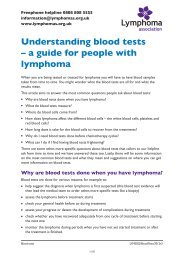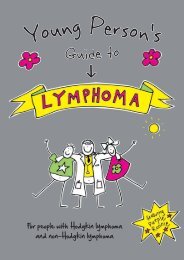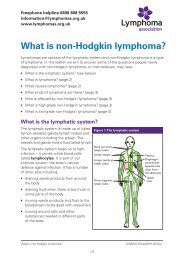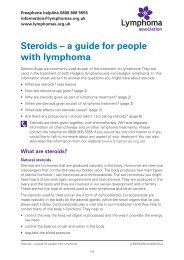Cutaneous T-cell lymphoma - Lymphoma Association
Cutaneous T-cell lymphoma - Lymphoma Association
Cutaneous T-cell lymphoma - Lymphoma Association
Create successful ePaper yourself
Turn your PDF publications into a flip-book with our unique Google optimized e-Paper software.
Stages IA, IB and IIA are considered to be ‘early stage’. Most people have thisstage of skin <strong>lymphoma</strong> when they are diagnosed. For others, the <strong>lymphoma</strong> is firstdetected at the more advanced tumour stages (stages IIB, III and IV) or, very rarely,when the blood is affected (stages IIIB or IVA, which is also called Sézary syndrome).The outlook or ‘prognosis’ depends on your age and general health and on how muchof your skin is affected. If less than a tenth of the skin is affected (ie stage IA) this isnot a life-threatening condition. Although it is rare for people with stage IA mycosisfungoides to remain completely and permanently clear after treatment, as long asthe <strong>lymphoma</strong> is controlled reasonably well it is unlikely to spread beyond the skin oraffect your life expectancy.If more than a tenth of the skin is involved or the <strong>lymphoma</strong> has involved the lymphnodes or other organs, remission is less likely to be so prolonged or permanent. The<strong>lymphoma</strong> can often be controlled for many years with treatment, however.Staging of other CTCLsThere are no recognised staging systems for the other, rarer CTCLs, but if youhave one of these other types of CTCL you might find that the medical team usesomething called the TNM system to describe your <strong>lymphoma</strong> stage. In this systemthey describe how much of the body is affected by assessing:● how many areas of changed skin there are, how big they are and which parts of thebody are affected (this is denoted by a ‘T’ and a number between 1 and 3)● how many lymph nodes are involved (if any) and which ones are involved (this isdenoted by an ‘N’ and a number between 0 and 3)● whether any other parts of the body are involved (ie parts that are not skin or lymphnodes, denoted by an ‘M’ and either 0 or 1).Changes in the TNM stage can help the medical team assess how well you areresponding to your treatment.Are skin <strong>lymphoma</strong>s curable?The grade of <strong>lymphoma</strong> – whether it is a slow-growing or a fast-growing type – andthe stage it is judged to be at when it is diagnosed are the two main factors that willdetermine how the <strong>lymphoma</strong> will behave, what kind of treatment you will need andhow the <strong>lymphoma</strong> is likely to respond to treatment. The table on page 7 listed whichCTCLs are considered to be slow-growing and which ones are usually faster growingand the stages were described on page 8.Strictly speaking, skin <strong>lymphoma</strong>s are not considered to be curable, but most skin<strong>lymphoma</strong>s never progress beyond the early stages. This is because they are often atan early stage when they are diagnosed, because they are slow-growing and becausethey respond well to treatment. If you have one of these skin <strong>lymphoma</strong>s the skinproblems will come and go and only need treatment some of the time. Having one ofthese types of <strong>lymphoma</strong> does not usually affect your life expectancy.<strong>Cutaneous</strong> T-<strong>cell</strong> <strong>lymphoma</strong>LYM0157/CTCL/2013v39/18












